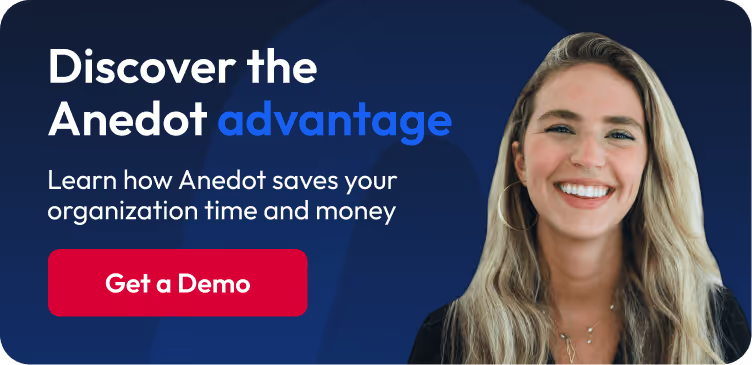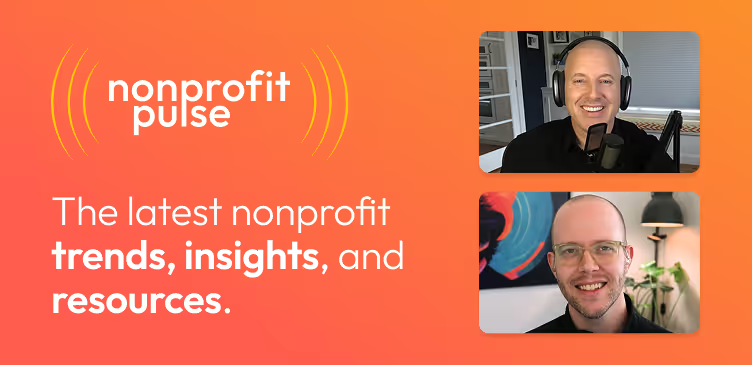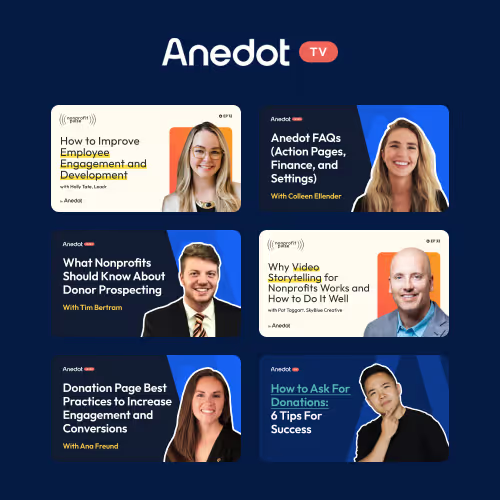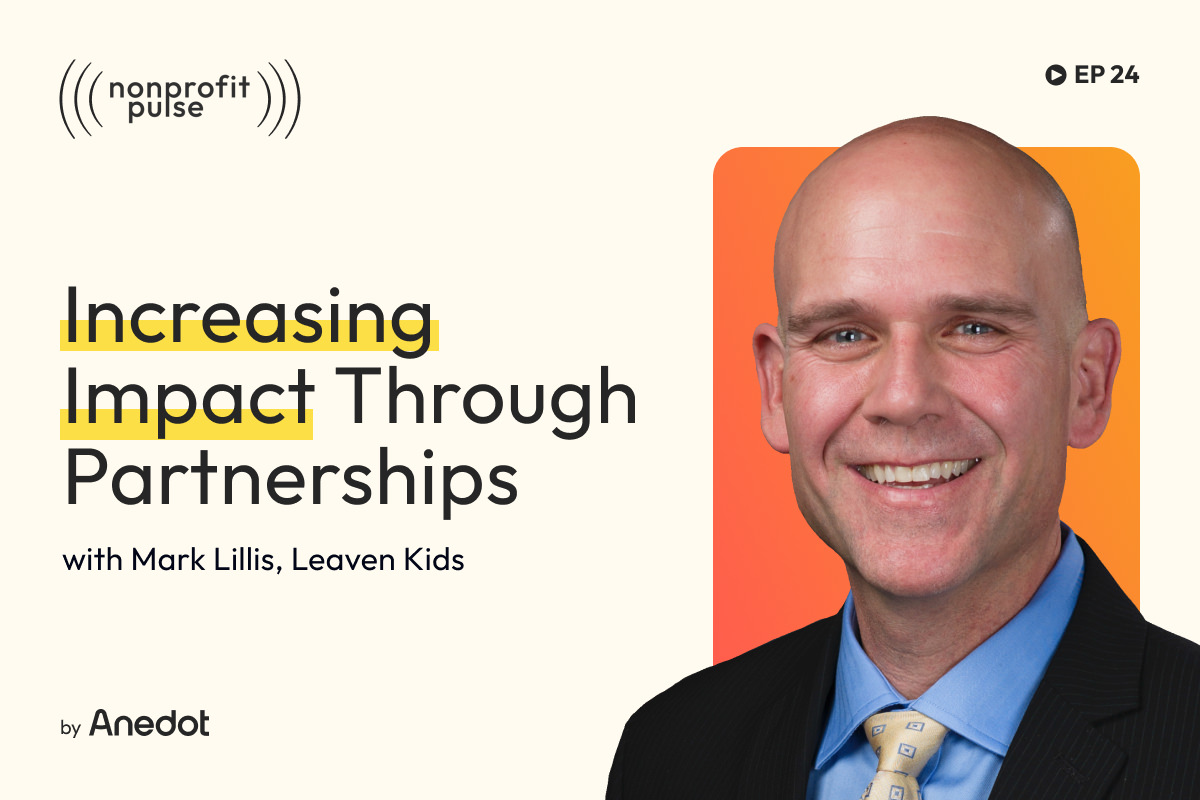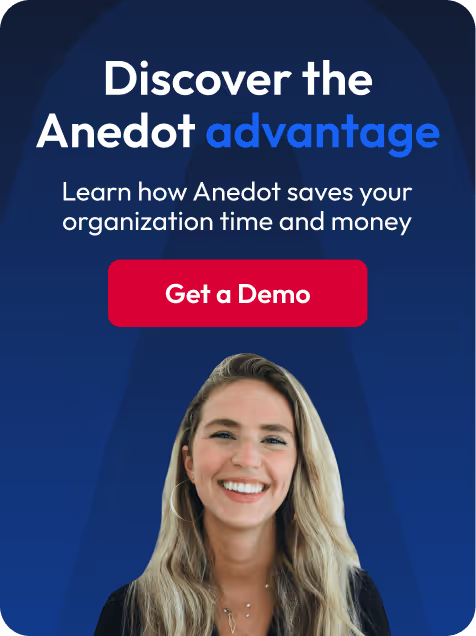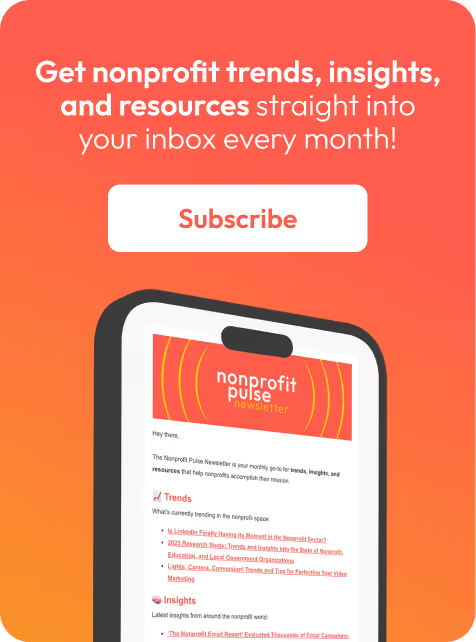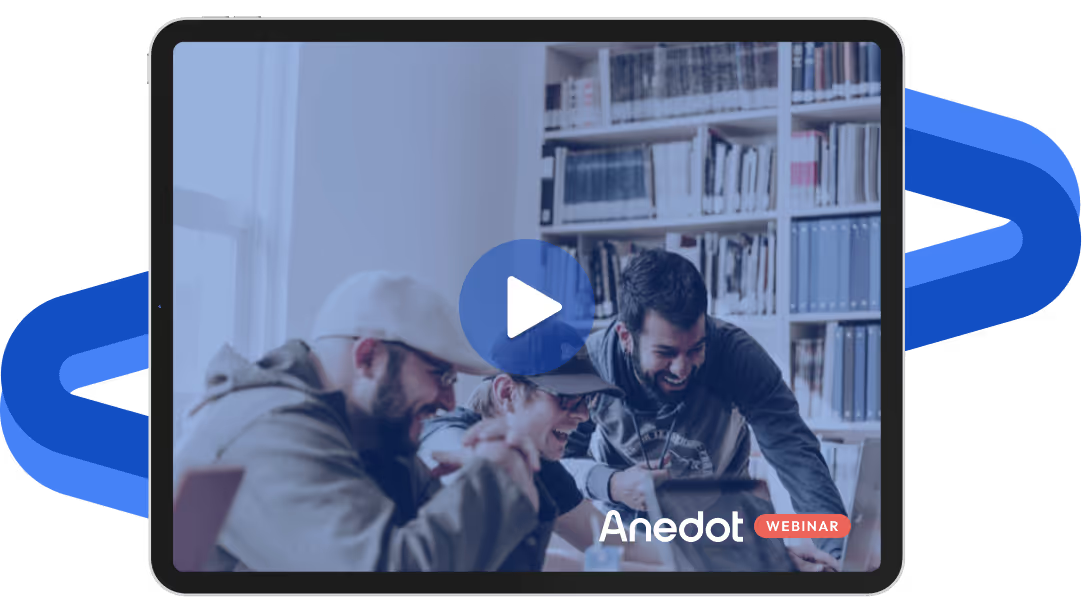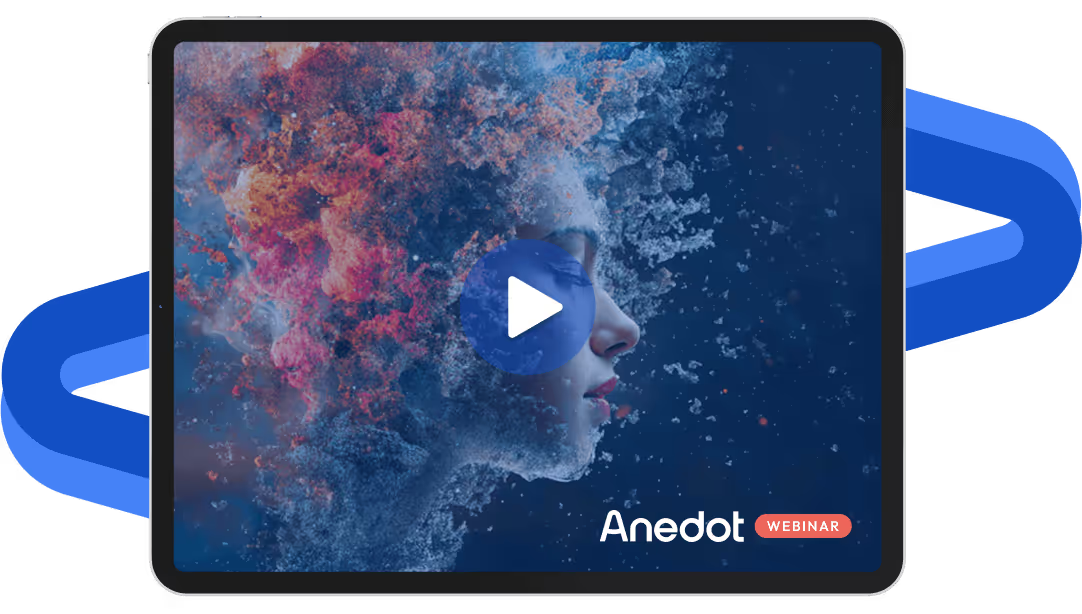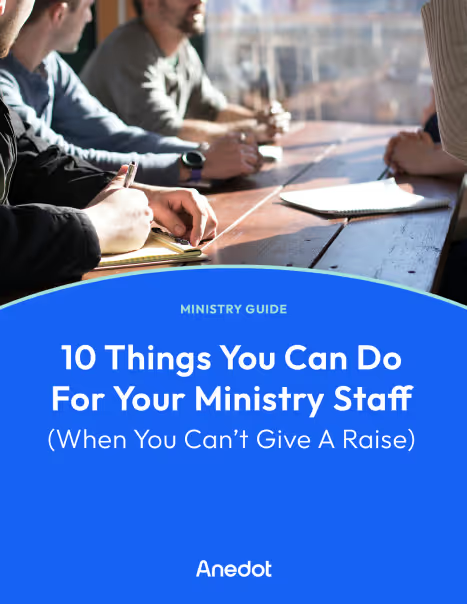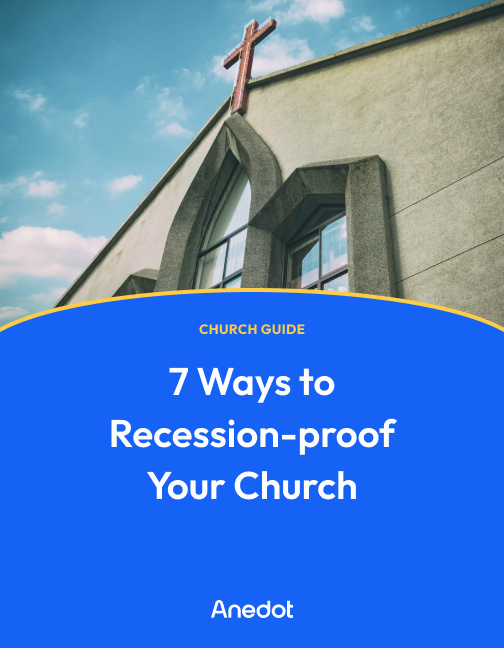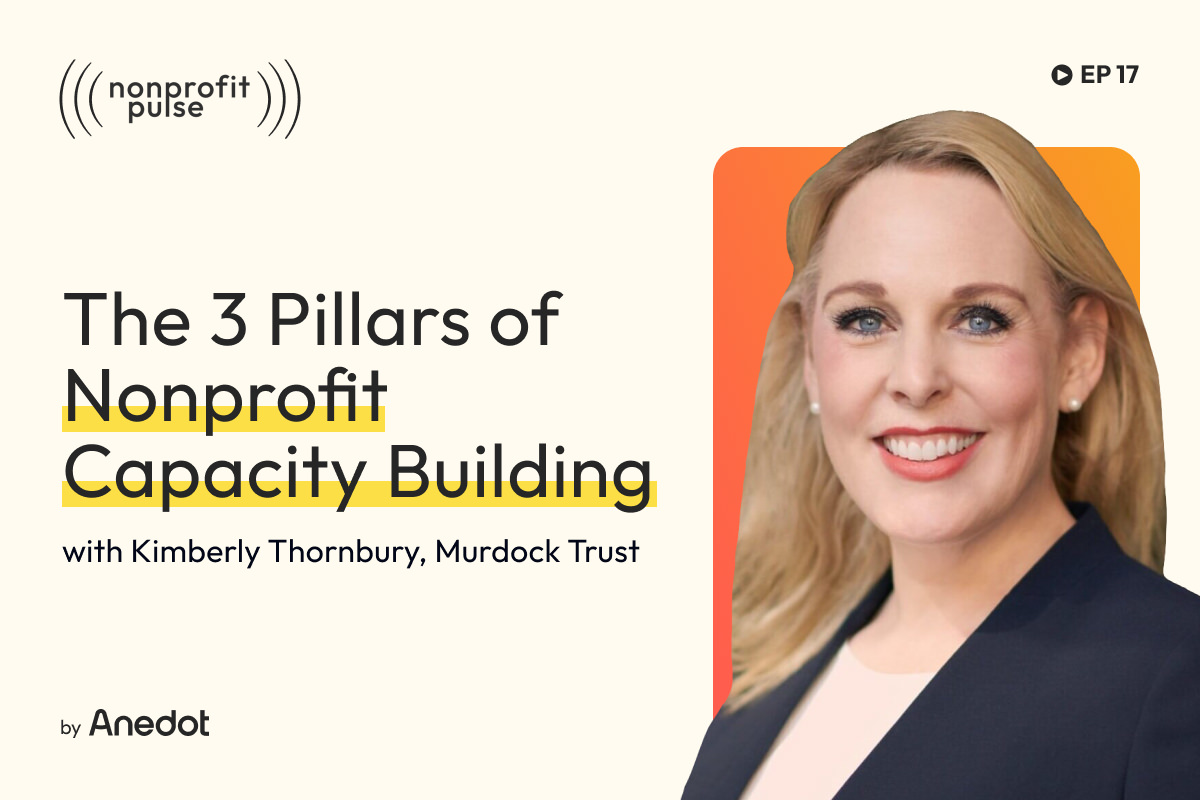Podcast episode transcript ↓
Josh:
Building a thriving nonprofit isn’t just about what happens within its walls. It’s rooted in the power of community collaboration.
Community collaboration can drive significant impact, helping organizations expand their reach and foster long-lasting change.
So, how can nonprofits find the right partners and cultivate meaningful relationships?
And what steps can they take to ensure these collaborations are equitable and beneficial for all parties involved?
I’m Josh with Anedot, and welcome to Nonprofit Pulse where we explore trends, insights, and resources that help nonprofits accomplish their mission.
On this episode, we are joined by Mark Lillis on the topic of how nonprofits can increase community collaboration.
Mark is the CEO of Leaven Kids, an award-winning nonprofit providing child learning centers inside apartment buildings in low-income and at-risk neighborhoods. Across California and Texas,
Leaven Kids is transforming lives and communities.
Hey, Mark, thanks for joining us on Nonprofit Pulse.
Mark:
Hey, Josh, thanks so much. Appreciate being here on the show.
The importance of community collaboration for nonprofits

Josh:
Yeah, excited to talk nonprofits and community collaboration today.
And just starting off, let's talk about the importance of community collaboration, because I know a lot of nonprofits either have some initiative around community collaboration or like to begin.
But maybe just setting the stage, can you share why community collaboration is important for the success and sustainability of nonprofits?
And really, what's all the great value behind that for both the community and the nonprofit?
Mark:
Yeah, well, we kind of talked a little bit sort of before the audience jumped on.
But, having nonprofits being involved in collaboration is so important.
We try to collaborate early and often with a local leader, schools, community organizations, to create programs that address the really unique needs of each neighborhood that we serve.
We try to build long lasting relationships to ensure our programs have some sustainable support, leading to greater outcomes for the children and the families who rely upon us.
And then our success stories across multiple cities, I think, are really a testament to the power of the community partners.
You know, early on, one of our founders was Mayor Harry Price for the city of Fairfield.
And I tell you, that man, he made impact upon thousands of people, just no exaggeration.
He was always engaged in community. He knew people and their stories and their families.
And he taught us some important lessons.
He taught us, hey, always thank people. Appreciate them.
And where possible, send a handwritten thank you note. So I send hundreds of thank you notes, handwritten thank you notes each month.
Seeing people face to face is really important. He helped us get the most out of our centers.
And he opened up probably the most of any of our centers. He traveled down with us to Southern California to meet with key stakeholders. When we opened our Inland Empire operations.
And then create community. He was so intentional in creating community.
We went to the Dr. Phil show, and we met Dr. Phil one time, and I'll always remember how he brought people along with us to not only experience the show, but to also meet Dr. Phil and have lunch at Paramount Studios.
He took what was sort of ordinary, and he made something really extraordinary of it.
So, creating that community, creating those partnerships is so important. And it is a real art, I believe.
Josh:
Yeah. And thinking about kind of how that community partnership really helps sustain a nonprofit, what comes to mind, at least maybe from your organization or from peer organizations that you've seen how that has helped carry along nonprofits?
Not just revenue, but their overall effectiveness and impact in the community.
Mark:
Yeah, there's some really good examples of where these community partnerships have enhanced our organization. We have a lot of them, thank goodness.
Examples would be with Kaiser Permanente, the U.S. Air Force, Jelly Belly Candy Company.
With Chick-fil-A, we won their national award twice. And I would say this is where a corporate partner could be much, much more than just providing money.
Chick-fil-A, they put on a nonprofit training that we attend. Members of their senior leadership, they've joined our board. And their national trainer kind of provides some insights to our leadership team.
And Kaiser Permanente has been the same way.
So we call upon these leaders to not only assist us in helping us grow, evolve, and get better, but in fact, our corporate promise that we have today that's sort of our North Star comes from a saying from one of the Kaiser Permanente managers.
So we received a grant from them, and she said, hey, you're going to do two things for me.
You're going to do what you say you're going to do, and you're going to do it really, really well.
So you can use these kind of anecdotal experiences to encourage and transform, and then also help to guide your organization.
Josh:
I love that. I love that and it sounds like something similar to what I heard about a story with Pete Rose, who just recently passed away.
And one of the stories of baseball legend Pete Rose is just how Pete was a superstar baseball player as an individual.
But the consistent stories around Pete is that he always made the people around him better.
And I love that you mentioned about kind of that expectations from partners about how they expect you to do certain things and you can expect them to do certain things so that reciprocity.
But how that could really positively influence the nonprofit's operations and culture in kind of setting that bar of, hey, we've got a great partnership and great opportunity and that means we need to deliver on the things we say we do.
Our yes needs to be yes. And we need to be great partners.
Mark:
Absolutely. Yeah. Yeah. In the nonprofit sector, we get grants, like, all the time.
But, you know what, when you can really find one of those corporate partners that are going to not only give you funding, but then also, walk alongside with you.
In my opinion, Chick-fil-A’s done an incredible job at scaling.
And so, to be able to learn a little bit about how they show hospitality, how they care for people, how they do more than just serve chicken is something that we've really valued in that good partnership.
So, yeah, it's awesome.
How to identify and engage mission-aligned community partners

Josh:
Yeah.
So, Mark, thinking about organizations who are looking to begin a partnership initiative or even grow their current partnership initiatives, what's some ways that nonprofits can really identify and engage those potential partners, that also align with their mission and values?
Mark:
Yeah. I think you have to identify those potential partners by sort of assessing what those shared values are.
You had a guest on, Stewart Severino, who shared. And I really like the idea of understanding the needs of the individual.
Understanding kind of your target audience. What makes them tick? What are sort of the mutual benefits?
→ Check out our episode with Stewart Severino: Nonprofit Innovation: Embracing Innovation as a Discipline for Lasting Impact
You want partners that are going to stick with you. You don't want to be turning and burning through partnerships because, like employees, that gets pretty old fast and it's time consuming.
So, I would say, go network within some industry events, community gatherings, they can help you to make the initial connection.
Nonprofit leadership is a contact sport. You can't do it and lead it behind a desk.
So we didn't have an office for the first eight years as we started our organization.
And it taught us the value of really kind of going out and meeting people, going to ribbon cutting, chamber mixers, and stopping in and talking to mayors, talking to government leaders.
And I would just say this is if you go to those events, be mindful when you're meeting with people or groups.
Don't just kind of give them the elevator pitch that all of us have been taught to give.
But, one of the things that, one of the tricks I learned from Chick-fil-A is to kind of start with your why and then go to the how. So it's far, far more impactful.
And it really will help for people to understand the kind of the motivation of why you do what you do.
I think transparency in your mission, when you're starting out, is really exceptionally important for building trust from the onset.
When we entered into the city of San Antonio, where we moved outside of California, we met with that community for two and a half years.
I know, it was a long, I had a full head of hair. Just kidding.
We met with Mayor Ron Nirenberg, the police chief, Chief McManus. We met with similar organizations, The Boys and Girls Club and the Salvation Army, as well as key business leaders.
We formed an advisory committee. We're a California based organization, but we formed an advisory committee so that we could really have a learning center that shaped into the culture of San Antonio instead of kind of dumping the California experience into Texas.
And it was all made up of local leaders from that community.
So really understanding the people and the values and the culture makes a big, big difference. And it helps to build that trustworthiness that I think people are really desiring these days.
Strategies for building long-term partnerships with local businesses, governments, and other nonprofits

Josh:
Yeah. That's a great segue into our next question. And you kind of mentioned some there.
But thinking strategically, what strategies would you recommend for nonprofits to consider creating this long term, mutually beneficial relationships with local businesses or local governments or even other nonprofits?
What would you say around kind of the strategy piece for organizations?
Mark:
Yeah, I'd say, create and maintain open communication with whoever it is that you're partnering with.
Celebrate your shared success stories, so that the stakeholders have an idea of what you're going to be moving towards either now or into the future.
I think understanding the stories of your community is, or the community that you're going into, and your current community could be really helpful.
I remember when we came into San Antonio, another San Antonio story, we went into this neighborhood that we were considering serving and we saw this boy, his name was Jordan, that was sitting on one of the park benches.
It was dead of summer. And you would think that a child who, his age was about 12 years old, would be out enjoying a lot of the summertime activities, going out and playing with friends.
And so, he was out there by himself.
General Miller came up, who is again, a member of our board, and she said, hey, what are you doing out here?
And he said, well, he goes, you see those guys over there? And he was pointing to a group that was over on the side.
They pay me and my friends to stand in front of those cars there because the other guys won’t shoot at them when we're standing next to them.
Basically, they're being used as human shields. That was their summertime experience.
So, really understanding what those stories are, and understanding the why you're going into an area, who you're serving, it provides what we call sort of a golden chatter that keeps you motivated when the work gets tough.
And oftentimes it gets really, really tough. And so, your partners will see that you have that tenacity to stick to it.
I would say that in the 15 years that we've been operating, we have kept over 90% of our partnerships because of really keeping to that mode of, hey, we're going to keep people informed.
We're going to tell them what we're doing. We're going to understand what the stories are, and then we're going to be able to stay for the long term.
Common challenges nonprofits can face with community collaborations and how can they overcome these obstacles

Josh:
Thinking of challenges that nonprofits face in pursuing new partnerships, new collaborations, Mark, what would you say that nonprofits are going to run into?
And how can they overcome these obstacles, these challenges?
Mark:
Well, I know this is a channel directed toward nonprofit leadership.
So I don't have to tell you or your guests that nonprofit leadership is challenging. It just is.
It feels like everything is urgent. Everything is on the front burner. There's few things that go to the back burner. You're dealing with people's lives.
So there's a lot of it that just doesn't look like the rest of the world or the rest of the industry that we find ourselves involved in work.
So I think you have to be careful that you don't, that you have an alignment with what your goals are.
You don't get into this thing that we are all familiar with, mission drift, kind of moving away from that established purpose of why you began.
There are communication breakdowns that occur all the time, these communication landmines that will come up in front of you or around you.
So you have to have continuous communication to help prevent misunderstandings or any type of misalignment.
I recall really early when we started, we were about maybe 3 or 4 months into this and we had a visit from the State Superintendent of schools, California State Superintendent of schools, Jack O'Connell.
And we had been asked if we would go, we serve kindergarten through fifth grade, and we've been asked if we would go to junior high and high schools.
So sort of the teen years, doing tutoring for that age group. And, I remember Mr. O'Connell saying, hey, don't do that. Stay focused on the one thing.
That's the one thing, stay focused on the elementary school, because by the third grade, if students aren't successful, they're dropping out of junior high and they're dropping out of high school.
So we need you to be successful. We need these kids to be successful in these elementary years.
So stick to it. And that was really wise advice because you can get turned all different ways.
People want you to be sometimes all things to all people.
And really staying focused, being laser focused, doesn't mean you can't evolve. But I think being focused on really the reason that you started is helpful.
Josh:
I love that and mission drift has come up recently on 3 or 4 episodes, regarding all sorts of topics, but just, it just reminds me how ever present the danger of mission drift is for nonprofits, whether they're beginning new initiatives or expanding current initiatives, there's just always opportunity, and there's always a heart to seek opportunity in nonprofits.
But yet it's so dangerous and can be so destructive to really the mission and the overall effectiveness of a nonprofit.
Mark:
Yeah, absolutely. Yeah. You have to know where it is.
And then, yeah, we are people who want to help others. I mean, that's why we got into this business. If we didn't want to do that, have a heart for it.
So yeah, just internally you have to kind of catch yourself and go, hey, I don't want to burn out myself and all the other people and all the other partners.
So let's focus and keep the main thing the main thing.
Josh:
Yeah. And even thinking about this specific topic of partnerships and collaborations, I can imagine if you had an ear with Chick-fil-A and they said, hey, we love what you're doing, but we'd also like you to be doing this other thing and we'd love to support that.
Well, that's a hard conversation to have when you get back to your board, to say, hey, this is a bit out of our scope.
It's kind of tangentially related, but it would bring in a huge corporate partner for us. How would you advise nonprofit leaders to kind of navigate that?
Mark:
Well, yeah, it's a good scenario. I think probably the converse is true.
So let's say in your scenario, you decide that, hey, we're going to go ahead and do whatever the corporation would like us to do.
You have to realize that it's just not that person or the corporation that is also attached to you. But it’s other corporations and other people.
And I will tell you that you'll end up getting a conversation that goes a little bit like this, huh, so we all supported you in our case, doing tutoring for children, and now you're out providing a food bank.
So you end up having this part of cross communication.
And really, I think some confusion that occurs within the supporters. And it turns out to be a bigger problem than it's worth.
Understand what you do and why you do it, and stay in that lane. Stay consistent and make sure that you're in the quadrant that you need to be in and that you're doing that really, really, really well.
So if anybody came up to me and said, hey, you know what I want you to do, I don't know, a food bank or whatever else it might be, or homeless or homeless services, I'd say, hey, you know what?
When we're in our learning centers, we're getting 80% increase in math and English arts. 90% of our students are receiving better self-esteem.
We're keeping to this goal and the focus that we originally began. And it has been fantastic, we've done it really well.
And we're just going to continue to march on what we do well. And I think most people will understand that, and particularly your staff will be very happy, that's for sure.
Because they don't want to be, they don’t want to be blown around like the wind. In terms of your organization.
Josh:
Yeah. And it seems like this could be handled kind of on the front end as well, when having those conversations with partners, by saying, here's what we do, here's where we're winning, here's how we measure it.
And with your partnership, we'll be able to do even more of this. And then that kind of frames the conversation and the expectations around, okay, what does our partnership mean?
Mark:
Right. Right. Yeah, absolutely. Yeah. No. That's it. That's exactly what you want to be clear with at the very, very beginning.
You want to be that laser focused with your partners and with the people who support you and certainly within your board and within your staff.
How to ensure community collaborations are beneficial to all parties involved

Josh:
So thinking about that idea of reciprocity, how can nonprofits really ensure that their collaborations or partnerships are equitable and really benefiting all the parties involved?
Mark:
Yeah, I think you have to treat people like you would want to be treated.
You have to really involve stakeholders. I mentioned our strategic advisory committees.
We use those in each of the areas in which we serve so that we hear what is going on in the local community.
We can hear about what's working, what's not working, how we're interacting and how we could potentially help. I think you have to be exceptionally aware of how resources that they're fairly distributed amongst for us, it's amongst all the 21 of our learning centers.
So we work hard on making sure that there's a uniformity of resources that are distributed.
You have to evaluate the impact. And I think you have to give, like, we give kids a real chance to give back.
So we were at one of our learning centers, and the families and the kids were having to see this fence that had graffiti and all kinds of foul language painted all over it.
It was just an absolute mess. And each and every day those kids would walk by this fence.
The families would walk out of their apartment units and they would see this fence that was just an absolute mess.
And it was depressing. Depressing for the neighborhood. It was depressing for the community, depressing for the residents.
So we mobilized members of the military, the Air Force, as well as some firefighters, police officers who came out and they brought the kids, and we created a painting party.
And they painted miles of fence in about 4 to 5 hours.
And to this day, that fence hasn't been vandalized, hasn't been touched because there's such a sense of pride within that neighborhood for the work that was done.
So I think really giving clients an opportunity to serve is one of them. That's one of the ways to really involve them and equitably in what you're doing.
The role of volunteers and community members in building successful collaborations

Josh:
So we've talked about nonprofit leaders. We've talked about partners and partner leaders.
But I want to talk about volunteers and really community members as well.
What role do they play or can they play in successful nonprofit collaborations and really, how can you maximize their impact and their involvement?
Mark:
Yeah, it's a good question. So volunteers are huge. They are a bridge for our organization.
They're a real bridge between the nonprofit and bringing some essential skills, local insight, and networks.
We have volunteers that come to each one of our learning centers. We rely upon them. They are a real integral part of the team. And we try to maximize their contribution.
We provide meaningful roles for them and ongoing training, and recognition of their efforts.
And then we involve community members in that planning and decision making, which we find is really important and beneficial.
I'd say there's probably three sort of things you can do to maximize the volunteer effectiveness.
One is you don't have to be perfect, but be genuine.
So what I mean by that is that, volunteers want to hear about the good service.
They want to hear about the good that you're doing, but they also want to know kind of what's hard. Because it's going to be hard volunteering. Let's just make no bones about it.
They're going to come into situations, they're going to see things. So really respect.
Number two, respect their time and efforts.
Have a good onboarding that takes place. It's so hard for me to watch volunteers just stand around.
And I think that part of that standing around is wasted effort. But it's also because there wasn't a really good plan in place starting off.
So we do a lot of thinking about the volunteer onboarding experience, and what we're having them come into every step of the way and then what they're going to be doing.
And then pull them up into your story.
Don't shelter them from the hardships that clients are facing.
But, show them really genuinely what is happening within a neighborhood or within the area that you're serving.
And then there are those moments where they get to have, where there's some incredible endings and they get to be the hero. So celebrate those successes and highlight them.
But, I think if you're genuine, if you respect their time and you pull them up into your story, you're going to have a really, really good volunteer experience for people.
Josh:
Yeah. And how have you seen your own partnerships really energizing volunteers or how have you been able to communicate that or leverage that to maybe recruit more volunteers or community involvement?
We mentioned the Chick-fil-A partnership, but I know you have others as well. What does that look like whenever you maybe gain a new partner?
And how do you share that with volunteers to really mobilize them?
Mark:
Yeah. So what we've been noticing, one of the trends we've been noticing is that there are some corporations that would like to give leave time for their employees to come out and volunteer.
So they come out for either a work party for a project, or they'll just come out each and every week.
So we've been noticing that with some of our corporate partners that they will do that, that they'll actually give leave time.
They'll give hours in a day, that they will pay their employee and then have them come out and volunteer with us, which is, just exceptionally helpful.
But, yeah, we've been noticing that trend within organizations, within corporations. And, being able to get that kind of, I think expertise, where we may not have it.
During Covid, for example, Genentech, helped us develop our online curriculum so that we were able to go online.
Yeah. Which was which is huge. We didn't have the the expertise in which to do it, but they put together the entire online experience for all of our students.
And then we morphed that into an adult experience as well.
So never, ever underestimate the power of the expertise that lies within whatever corporation is that you're going to partner with.
An example of a community collaboration that amplified impact

Josh:
Mark, I wonder if you have an example of a collaboration or a partnership at your organization that really, maybe transformed is too strong of a word, but we'll use it, transformed a certain part of your operations or maybe even just significantly amplified your org’s impact in a certain area.
Mark:
Yeah. Well, during during Covid, again, in the beginning days was a lot of shutdown that occurred.
And particularly amongst our farms and our farmers were, we have a lot of farms in our local area. And so it was impacting many of the families and the children that we were serving.
And we heard that resources were getting really low and the people were having to make a radical acceptance of whether to sort of pay rent or buy groceries.
So, we gathered our partners from the military, the fire departments, the churches, the local schools, and they were still communicating with parents at that time.
And we did kind of a good old fashioned canned food drive.
We put out these big barrels at our local fire department, and they were able to gather the food, they sanitized, repacked, and distributed. We were able to distribute hundreds of pounds of food to residents.
And we just simply put it on their doorstep. And then we walked away. And I'll just never forget a mom who happened to catch us dropping off a box.
She said, gosh, I was on my last leg and I was about to go hungry for the entire week. She just couldn't stop thanking us for about 20 minutes.
It really amplified our impact because it demonstrated that we weren't just going to parachute in and out, that we were going to be there, when the going got tough. And then further strengthened the trust that we were able to build within that organization and also within our partners.
Our partners realized that, hey, these guys are going to quickly mobilize and they have the capacity to quickly mobilize a group of people.
I heard a great quote that says, hey, you can go at this slowly alone, or you can get into partnerships and go out at much faster.
I think this is one of those areas that we sort of demonstrated that we could go at this much, much quicker if we just bring some people together, provided a base and a network in which they can grasp onto, and we were able to feed hundreds of residents in that neighborhood during a real trying time.
Closing thoughts

Josh:
That's awesome. Thinking about trends, Mark, what trends are you seeing out there with community collaborations? Partnerships?
Maybe both from the nonprofit side, but also even from the community side.
You know, all of our communities are now different after after Covid. It's like we all kind of hit a psychological and social reset in many ways where I think a lot of us hunger for more community.
We're seeing our local communities as more valuable than ever. So what trends are you seeing out there?
Mark:
Yeah, I think, just what you alluded to, I think people are really eager to get out and to socialize, to make a difference. To do it in a meaningful and impactful way.
So one of the trends that I mentioned is that we're seeing more corporations who would like to actually give leave time so that their employees can come out and be a part of the work.
But they're also going to be very thoughtful about who they're going to choose, and they're going to make sure that you have something together.
They're going to make sure that you're organized. They're going to make sure that it's a well thought through program and product.
So really be able to demonstrate that on the front end. And I think that you will fall into really kind of where the trends are these days, which just people want to get out, they want to make a difference.
They want to be a part of something that's bigger than themselves. And they really do long for those that golden chatter, those good stories that are out there in which people's lives are being impacted and made a difference.
Josh:
Yeah. And life was so hard for so long for so many people.
I think that what you just said makes so much sense about people are longing for positive stories or helpful stories for people helping others and lifting each other up, this kind of post-Covid era that we're in.
So thinking of resources, what resources would you recommend to our audience around community collaboration and partnerships?
Mark:
Just kind of add another piece to what you just said there, Josh, and that is that we do that area really, really, really well.
So, we provide that area of hope, we provide that help. And so, really maximize what we do, we don't create widgets, but we do create service.
And I think that part is what people are really, really kind of really also longing for. So thank you for bringing that up.
So I would share with the audience that we learn a lot from industry, as I mentioned.
I tend to read community building type books, as well as kind of leadership and mentorship books like by Peter Drucker, Spencer Johnson, like Who Moved My Cheese?
Doctor Robert Lupton, who went out into a community and created something from nothing.
The 7 Habits of Highly Effective People by Doctor Covey. I read a lot about kind of the life of Mother Teresa, who mobilized the world to care for the poor in the slums of Calcutta.
But we also attend trainings by the Disney Institute.
For a while, we would find one of our industry leaders, CEO or a manager or a CFO. And our staff would go and hear their perspective on a topic, whether it be leadership, employee organizational development.
And these were really helpful. And they didn't really cost us anything except for time.
And they gave us a really good insight as to what their experience was, as well as it gave us an opportunity to tell that organization or corporation about what we did in our mission.
So, I’d say those are some things that I've kind of learned along the way.
Josh:
Yeah. Thanks for sharing. And for our audience, as always, you can go to Nonprofitpulse.com and find the show notes there for this episode and find links to some of the resources that Mark mentioned.
So it's Nonprofitpulse.com. And you'll see Mark's episode.
So Mark, looking at our last question of the interview, it is my favorite question.
And it is if you were standing on stage in front of 1,000 nonprofit leaders and can share one thing about community collaboration with them, what would you say?
Mark:
Supporters, they do not necessarily have the time, but they have the heart.
Josh:
Love it. Mark, this has been such a helpful conversation.
We're closing out the year here in 2024. And I know a lot of nonprofit organizations are reassessing their initiatives and their growth plans.
I'm sure that community collaborations and partnerships are on the top of that list. And so I hope they can listen to this episode and find value in it.
And again, you can check out the show notes for more resources or to read a transcript.
Mark, thanks so much for joining us. And maybe we can talk again towards the end of next year and see what all is going on at your organization and just across kind of the partnership landscape.
Mark:
Absolutely. We’ll grow, we’ll evolve. I pray we strengthen this area even more.
I'll just encourage your listeners, your viewers, hey, it's not easy, but start. Just take a step, start and you won't ever turn back. It's awesome.
Josh:
Awesome. Thanks, Mark.
Mark:
Thank you.
Josh:
Hey, thanks for listening.
If you enjoyed this conversation, please share or leave us a rating and review wherever you listen to podcasts.
Also, head on over to Nonprofitpulse.com to sign up for our monthly newsletter, as well as check out all the links and resources in the show notes. We’ll see you next time.
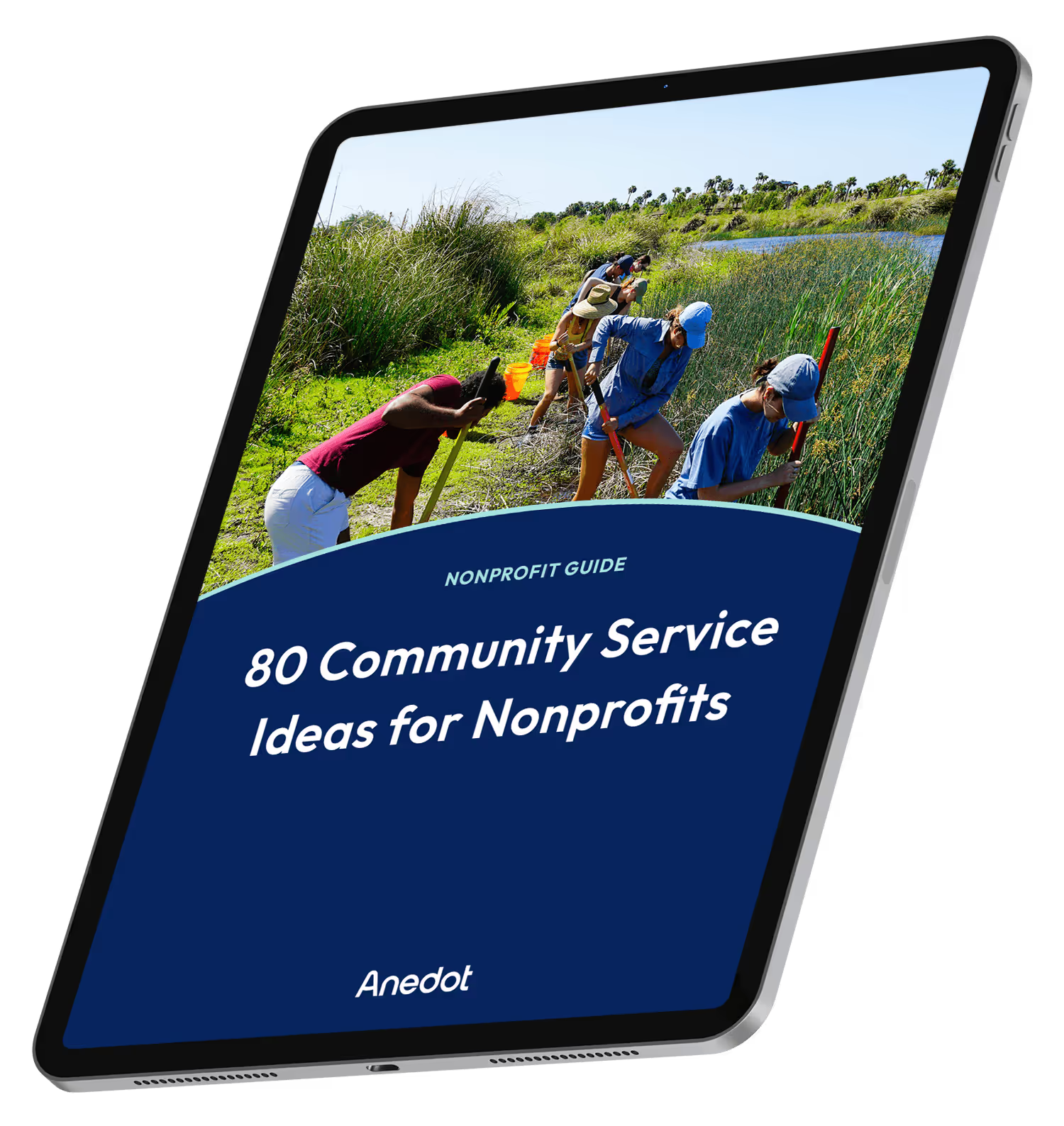
80 Community Service Ideas for Nonprofits
